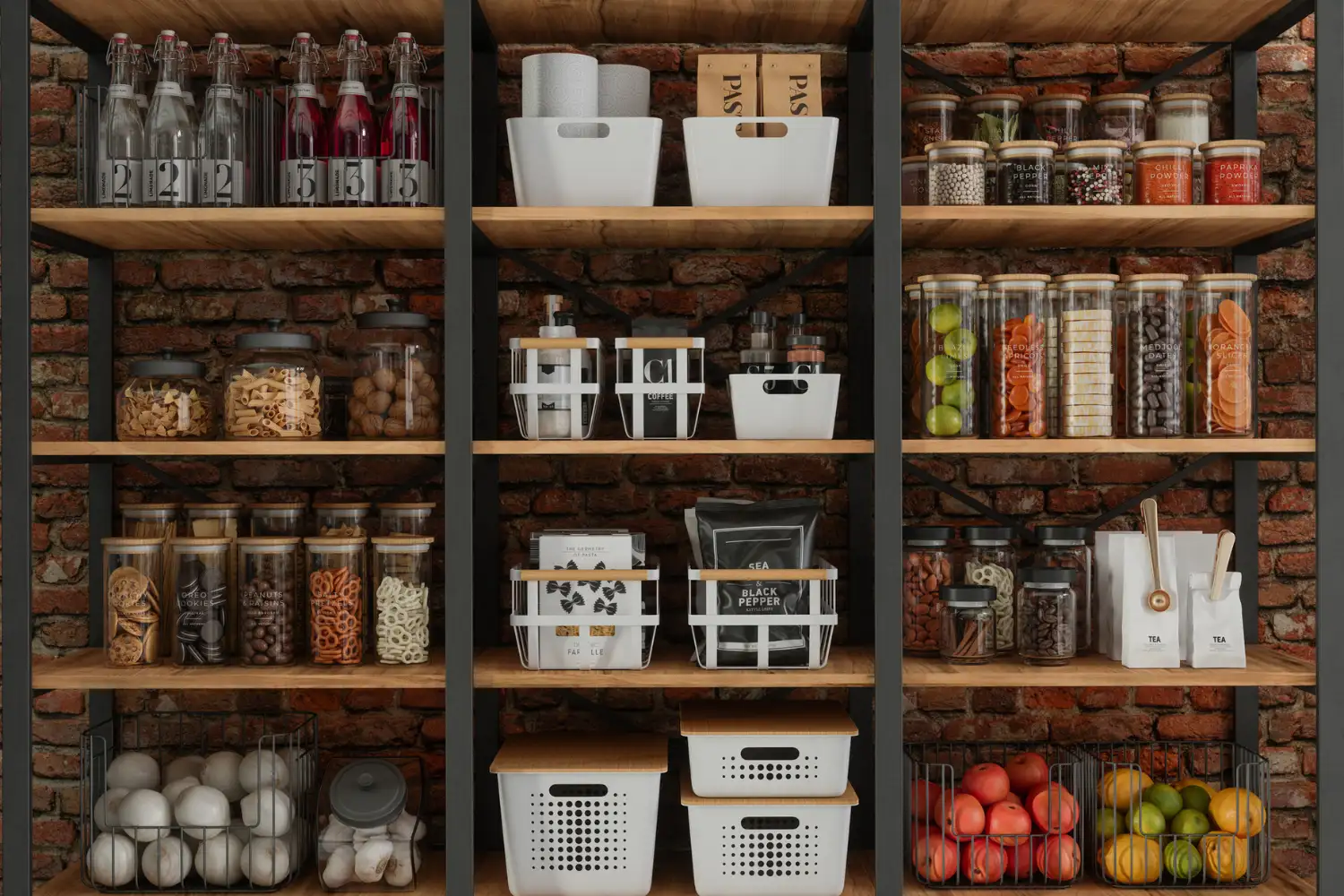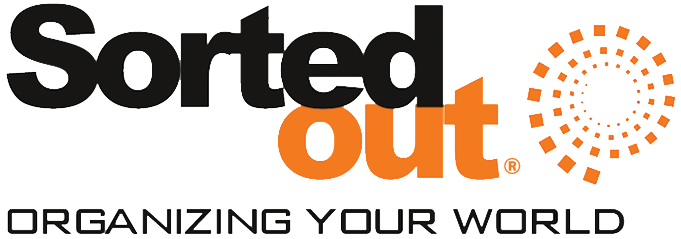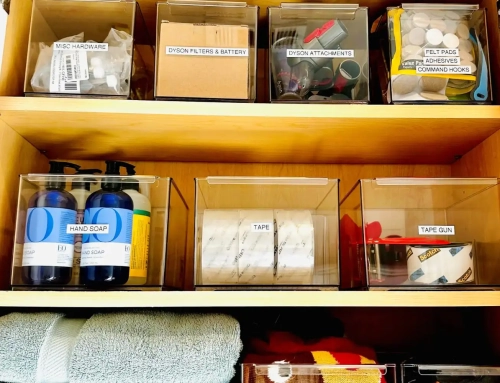
Pantry organization isn’t something that needs to be overhauled or updated too often if regular maintenance is completed throughout the year, but a new or special diet is surely something that will require a pantry makeover! Whether it’s temporary, for health reasons, or simply because, introducing a new diet takes hard work and effort. One thing you can do to best support you (or a household member) with a special diet? Declutter and reorganize your pantry to best suit the needs of everyone in the house! Read on for our experts’ tips on how to create a pantry that accommodates special diets.
How do I start decluttering?
The first step of any pantry overhaul is to declutter! And the best way to start decluttering any space is to empty it. As you empty your pantry remove and throw away any expired or unused items. You’ll likely need to make room for new ingredients you’ll need for your special diet, so this will free up wasted space. You also want to check labels for ingredients that do NOT align with your new dietary restrictions or needs. For example, if you’re going gluten-free, all items with gluten can be donated or thrown out. Other common ingredients to look out for and possibly remove are refined sugars, dairy, nuts, etc.
What is the best way to categorize my pantry items?
Next, you should sort pantry items into categories based on your diet and meal plan. Common categories may include:
- Grains (GF oats, quinoa, rice, etc.)
- Canned Items (low sodium, veggies, etc.)
- Snacks (Keto or Paleo approved, etc.)
- Flours/Baking Supplies (almond & coconut flours, oils, etc.)
If your diet restricts specific foods or categories (i.e. no processed foods) then separate food items in those categories into an “off-limits” pile to donate. If you are unable to eat them, it’s best to remove them from your home and get them into the hands of someone who will appreciate them, so nothing is unnecessarily wasted.
Will labels help me keep my pantry organized?
Labels are always a good idea in a pantry, but they’re arguably even more important when specialty items/ingredients are involved. Use clear, labeled containers for storing dry goods, especially if working with special alternative items (almond flour, gluten free oats, etc.). Labeling sections of the pantry is also important to help you avoid restricted ingredients, and to help others in the household if their diet is not restricted. The type of label is up to you: sticker labels, chalkboard tags, or pantry bins with built-in labels all work! In addition, color coding might also help with easier identification (especially if you have kids, a variety of differing restrictions, or members with ADHD in the household).
What are the best containers/bins/baskets for pantry organization?
In a pantry, we recommend clear, airtight containers. Clear airtight containers preserve freshness and allow you to see what you have, along with how much. This added benefit helps when planning grocery trips, too! Transparent bins are helpful, especially for diet staples like rice, noodles, chickpea pasta, dairy-free items, etc. When picking storage containers, be mindful of what will work FOR YOU. If you know you won’t be accountable to decanter items such as rice, etc. opt for a clear bin for the boxes/bags rather than an airtight container or glass jar with a lid.
If your specialty/new diet comes with a plethora of new ingredients, there are a couple of other organizational items that may help keep your pantry in order. Adjustable shelf dividers are helpful because they keep taller items from falling over. Turntables or lazy susans are great for accessing spices/jars easier (especially in the corner spaces of your pantry!) Always try to group small, like items together. Store items such as packets of spices, small packages, and individually wrapped snacks in lid-less bins/baskets to make them easier to grab and go.
How can I make all items in my pantry easy-accessible?
As you return items to your pantry, you want to organize them in a way that works best for YOU, but there are some common “best practices”. Frequently used items should be placed in easy-to-reach spots while less frequently used items can be placed on higher (or lower) shelves. If you have restrictions when it comes to your snacks, place these items at eye level for quick identification so you aren’t having to look past unapproved items that might be tempting to grab instead.
If you have others in the home that also follow dietary restrictions or preferences, create dedicated zones or spaces within the pantry for each household or family member. This prevents confusion and ensures everyone can easily find their preferred or required foods, without cross-contamination. You can also create zones on each shelf or bin/container, for foods such as ones that are vegan, gluten-free, keto, allergen-free, etc. Another zone we recommend including is a “convenience section”. In this space, store easy-to-grab, pre-packaged single-serve items for snacks or quick meals. You can also pre-portion and store snacks like nuts, dried fruit, etc. into small bags if they aren’t already in single-serve packaging. Items for busy days, such as protein bars or meal-replacement powders, would also go in this zone so they are easily accessible.
How can I maintain and KEEP my pantry clutter-free?
You want to organize items in a way that best sets you up to KEEP them organized, but you should also do semi-regular maintenance to avoid clutter build-up. When adding items to your pantry, place all the older foods towards the front so that they are used first. Newer items should always go toward the back because it prevents food from being forgotten or expiring. If you are using clear containers, adding a label with the expiration date is helpful!
You may want to use an app to track the contents of your pantry so you can avoid purchasing duplicates. You might also consider a meal-planning system that is tailored to your diet, so you know exactly what to purchase when your pantry starts to get low. You can keep track of what items are being used regularly/frequently vs. items that are being thrown out often, so you can adjust your meal planning and grocery lists accordingly.
For maintenance, set a specific day of the week to regularly reassess the contents of your pantry and reset the space as needed. Check expiration dates, rotate older items to the front, and ensure all items are in the correct containers/bins. A great time to do your weekly assessment is BEFORE your next grocery trip, to ensure you are only purchasing items you actually need.
You may have a long-term pantry set-up that has been working well for you, but a special or new diet can certainly shake things up and that’s where we thrive! If you would like extra advice or help getting your pantry in shape, our inbox at info@sortedout.com is always open and we’d be happy to help you find the best way to eliminate the clutter for good.
Looking forward to hearing from you,
Tonia
Request a Consultation
There are so many ways that organization can help take back a space that is overwhelming and bring it to functional! We are excited to help start your journey to an organized and productive space.






